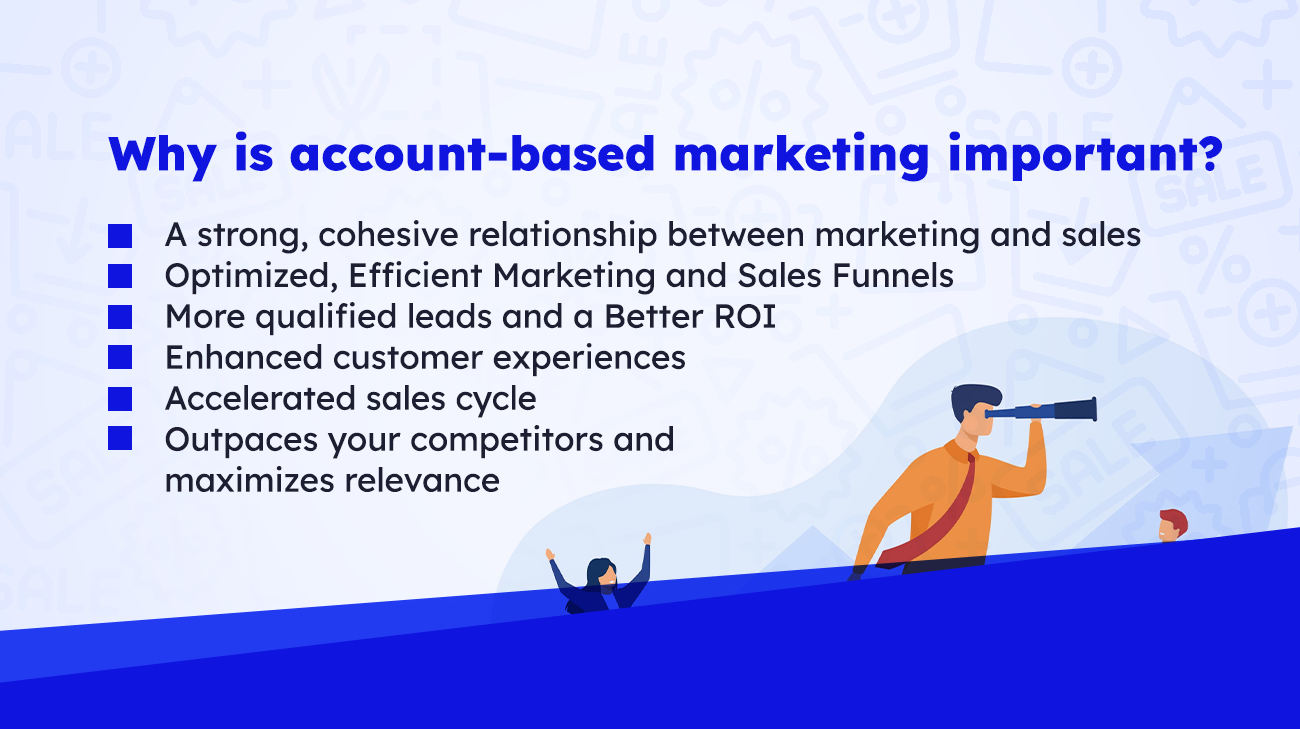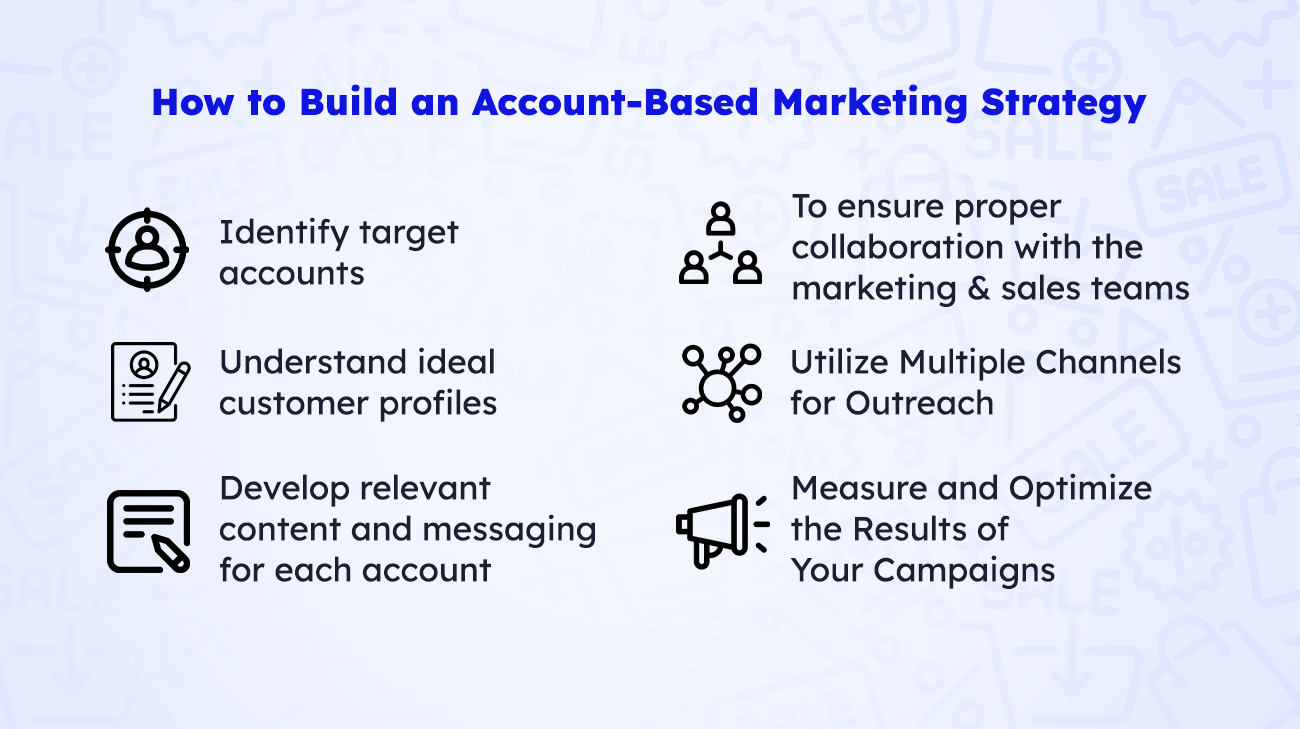If you’re looking to maximize your pipeline with high-quality accounts and see a concrete return on investment, account-based marketing (ABM) should be at the top of your list. So what exactly is ABM?
Imagine a world where you could begin selling directly to the most useful and highest-value accounts that perfectly match your business.
No more aimless marketing to leads incompatible with your company’s purpose, allowing you to engage and satisfy these targeted customers.
With ABM, you can quickly identify and target valuable companies, maintain cohesion between sales and marketing teams, and initiate the process of captivating your accounts more efficiently.
What is an account-based marketing strategy in B2B?
Account-based marketing (ABM) is a powerful B2B marketing approach that enables sales and marketing teams to collaborate to pinpoint, contact, and close deals with the most suitable accounts.
In ABM, quality over quantity is the key. By engaging a few valuable accounts instead of many low-value prospects, you’ll save time and resources while seeing a higher ROI on your investment.
When high-value customers are interested in your product early on in the buying journey, account-based technology provides a solution that enables both marketing and sales teams to swiftly access these signals.
What Is The Long-Term Objective Of ABM?
With ABM, teams can strategically and effectively generate revenue throughout the entire funnel—from awareness to building the pipeline, accelerating momentum, retention, and expansion. The more success a team experiences with ABM initiatives, the greater its acceptance among other divisions in the organization.
Many companies have gone the extra mile and appointed an ABM manager to ensure their strategies are properly implemented for maximum success.
What Makes ABM Different From Lead Generation?
Unlike lead generation, ABM targets specific accounts and builds personalized relationships with them.
On the other hand, lead generation focuses on creating a list of leads who have expressed interest in your product or service. These leads are typically further nurtured by sales teams to drive conversions. While lead generation can still be a valuable part of any B2B marketing strategy, it doesn’t quite compare to the targeted nature of account-based approaches.
Account-based marketing allows you to reach out directly to accounts representing the most lucrative business opportunities, thus making sure you’re investing resources in the right places and achieving the best return possible.
For instance, if you’re a SaaS B2B business targeting financial institutions, there may be better approaches than traditional inbound marketing. You might create content for finance companies and hope they come to you when it’s time to make decisions, but how do you know if your messages are resonating?
You can target your content to the employees of the top ten banks in America or anywhere around the globe, and you still have no idea if they are the decision-makers when it comes to purchasing. Without tracking who makes those calls, your efforts could easily go unnoticed.
That’s where ABM comes in.
By concentrating on the quality of prospective accounts rather than their quantity, ABM strategies allow teams to devote their attention and resources to offering content that is relevant and personalized messages for higher-value customers.
Why is account-based marketing important?


ABM allows your business to treat high-value customers as individual markets. By customizing the buyer’s journey and creating personalized content, communications, and campaigns specifically for those accounts, you can maintain a stronger customer relationship with higher ROI results.
We’ve compiled a list of the greatest benefits other businesses have reported, so you can decide if ABM is right for you.
1. A strong, cohesive relationship between marketing and sales
Marketers and sales teams have traditionally operated in two separate worlds. Marketers were busy crafting campaigns for specific markets and industries, while salespeople only engaged buyers likely to convert.
But thanks to the power of ABM, these departments now work together toward converting target accounts—no more debates on lead quantity or quality! By unifying their efforts, both sides can benefit from a streamlined approach aimed at bringing maximum results.
2. Optimized, Efficient Marketing and Sales Funnels
ABM allows you to optimize your sales funnel, ensuring the right accounts are targeted and nurtured. No more wasting time on leads that aren’t a good fit. ABM provides a way to target specific accounts with personalized messages and content, so they can move through the sales cycle faster and reach their end goal—conversion.
3. More Qualified Leads And A Better ROI
Account-based marketing is a superior strategy to traditional B2B approaches, allowing you to prioritize quality over quantity and reach highly qualified leads who are far more likely to convert. Your team will spend fewer resources targeting potential customers while reaping desirable outcomes.
It’s an efficient way of generating value. It’s the perfect solution for B2B companies looking to maximize their ROI while delivering high-value leads and creating strong customer relationships.
According to the 2020 ABM benchmark study by ITSMA, 76% of marketers experienced a higher return on investment when using an ABM strategy than other campaigns.
While it may take more than one survey to convince decision-makers of the expansive value of ABM, you can still demonstrate its efficacy by initiating a pilot program and presenting tangible results.
4. Enhanced customer experiences
Instead of offering content to a wide range of people and industries, ABM takes a more focused approach. You can provide personalized touchpoints aligned with each buyer’s journey through careful research and campaign design specifically for one account.
5. Accelerated Sales Cycle
With ABM, sales and marketing teams can precisely hone in on target accounts, leading to a rapid acceleration of their sales cycles. ABM’s strategy is deliberately designed to draw prospective customers quicker while building trust quickly—far faster than regular marketing programs.
6. Outpaces Your Competitors And Maximizes Relevance
ABM provides you with the capacity to offer bespoke solutions, leaving each customer and prospect feeling as though targeted answers have adequately addressed their concerns. By targeting ideal customers through ABM, you’ll be able to make a powerful impression that resonates with them and encourages purchase.
This provides an advantage over your competitors, as ABM enables you to reach the high-value accounts they may not even have access to.
How to Build an Account-Based Marketing Strategy


Now that we have a better understanding of ABM and its benefits, let’s dig into the fundamental building blocks of an ABM strategy.
Below are important factors to consider when developing an ABM strategy:
1. Identify target accounts
Crafting a successful ABM campaign always begins with accurately identifying potential target accounts. A good benchmark for this process is to develop your personalization and outreach strategy based on how close you are to revenue.
To ensure maximum benefit from all the hard work, marketers must be sure that sales teams are on board when selecting accounts that reflect your company’s ICPs.
2. Understand your ideal customer profiles
For any successful ABM strategy, having an “ideal customer profile” (ICP) is a necessity. An ICP provides insight into which product or service would best serve individuals in your target market. Ultimately, you want to ensure that customers who purchase from you will benefit from their decision.
Knowing your ideal customers is essential for creating an effective marketing plan. A well-defined customer profile will give you a clear understanding of the audience that you’re engaging with, allowing you to craft content personalized to their needs and interests.
With this knowledge, your team can easily identify how to reach and engage potential leads more effectively. Those who build strong ICPs have been proven to enjoy 68% higher account conversion rates.
3. Develop relevant content and messaging for each account
Once you’ve identified the target accounts and created a clear ICP, developing and updating existing content and messaging that speaks directly to your prospects is key. This involves crafting content with relevancy in mind, understanding the customer’s needs, and providing personalized messages to each account.
The goal is to create captivating and insightful content that intrigues prospects. Add calls-to-action (CTAs), which will motivate customers to take the next step—whether it’s downloading a whitepaper, scheduling an appointment, or subscribing for updates.
4. To ensure proper collaboration with the marketing and sales teams
For ABM campaigns to be effective, the marketing and sales departments must collaborate from beginning to end. While the marketing team oversees setting up and executing campaigns, sales can focus on engaging with target accounts for conversion.
Here are three ways team members from both departments work together:
- Establish a comprehensive communication plan: Communication is the foundation of any successful collaboration. Arrange for weekly, monthly, and quarterly check-ins to strategize about ABM tactics, evaluate outcomes, and map out future campaigns.
- Maintain clarity and transparency between the marketing and sales teams: Create transparency between marketing and sales by ensuring they both promote the same value proposition. Agree on messaging and rules of engagement beforehand to avoid any unwanted confusion, like targeting different accounts or overlapping outreach efforts.
- Establish definitive service-level agreements (SLAs): To ensure no conflict arises between the sales and marketing teams, it is critical to define key performance indicators (KPIs), deliverables, and timetables to maintain accountability.
5. Utilize Multiple Channels for Outreach
No two ABM strategies are identical; each one is tailored to meet the unique needs of its respective business. Your selection of channels will thus depend on your approach to ABM and how much you are prepared to commit to each account.
Marketers have numerous channels to choose from when crafting a successful campaign, including email campaigns, direct mailings, and ads; attending events or organizing webinars; leveraging social media networks; and creating digital content such as blog posts and videos.
For example, email campaigns are important for nurturing leads and keeping prospects engaged over time. With emails specifically targeted to an account’s ICP, you can nurture relationships and increase the chances of success.
6. Measure and Optimize the Results of Your Campaigns
The last step in any ABM campaign is to track its success by measuring KPIs. These include cost per lead, conversion rates, click-through rates on emails and social posts, lead-to-customer conversation rates, etc.
By keeping an eye on these metrics and making changes accordingly, you can optimize your ABM campaigns for better results. For example, if you want to increase the ROI of your ABM campaigns, consider reducing the cost per lead or improving click-through rates.
Final Words
Account-based marketing is the perfect way to maximize pipeline ROI by targeting high-value accounts that are more likely to convert into customers. ABM may be overwhelming for beginners, but you can run highly successful campaigns with a few simple steps. Start with a clearly defined ICP, relevant content for each targeted account segment, multi-channel outreach methods, and continuous monitoring of key metrics; you’ll be able to generate higher-quality leads and improve your bottom line.


